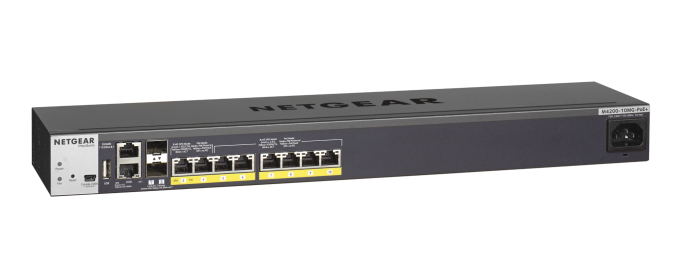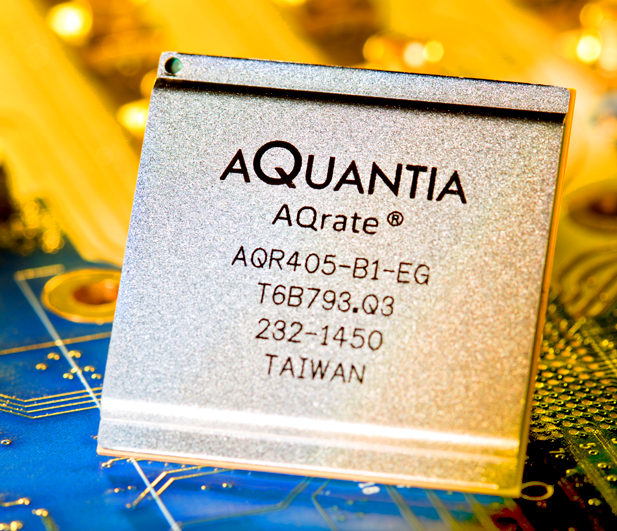NBASE-T Alliance Receives Boost with IEEE P802.3bz Approval for 2.5G/5G Ethernet
by Ganesh T S on October 3, 2016 8:00 AM EST- Posted in
- Networking
- 10GBase-T
- NBASE-T

Wired networks relying on traditional Cat 5e and Cat 6 cables (at their maximum channel length of 100m) have been limited to 1 Gbps so far. At the other end of the spectrum, 10 Gbps required augmented cables (Cat 6A or better) for transmission lengths typical in enterprise and business scenarios. Despite 10 Gbps Ethernet having been around for more than 10 years now, cost and power consumption aspects have limited its adoption on a wider basis. The NBASE-T Alliance was created to bring in support for speeds between 1 and 10 Gbps, while retaining the use of existing cabling infrastructure.
NBASE-T has become popular because it can act as an effective wired backhaul for 802.11ac wireless access points. With theoretical speeds exceeding 1 Gbps, the time and environment are right for technology that can replace the existing 1 Gbps network ports. 10GBASE-T is not really an effective solution because of the cost as well as power requirements aspect. Almost all enterprise access points are powered using Power over Ethernet (PoE). The IEEE 802.3af-2003 standard allows for up to 15.4 W (12.95 W assured), while PoE+ (IEEE 802.3at-2009) can provide up to 25.5 W. However, the 10GBASE-T standard doesn't currently support Power over Ethernet, even though it is being considered. Therefore, 10GBASE-T has not turned out to be an effective and universal solution to this challenge despite the bandwidth availability. This is where the 2.5 Gbps and 5 Gbps options provided by NBASE-T equipment become attractive. Some NBASE-T switches already implement PoE / PoE+, and are effective solutions for driving compatible 802.11ac wireless access points.
Netgear's M4200-10MG-PoE+ Managed Intelligent Edge Series Switch with 5G/2.5G Switching for High-Speed Wave 2 802.11ac Deployments
On September 23, 2016, the IEEE P 802.3bz 2.4G/5GBASE-T Task Force (which started work in March 2015) ratified the IEEE P802.3bz Standard for Ethernet Amendment: Media Access Control Parameters, Physical Layers and Management Parameters for 2.5 Gb/s and 5 Gb/s Operation. It allows 2.5 Gbps operation over standard Cat 5e cables, 5 Gbps over Cat 6, and 5 Gbps over Cat 5e under select conditions. All of these are up to at least 100m channel lengths.
The AQrate Family of NBASE-T PHYs from AQUANTIA - One of the Leading Market Players
The ratification is a big boost for the NBASE-T Alliance. The standardization also lends more credence to the NBASE-T plugfests scheduled to be conducted in October 2016. It will also bring more 2.5G/5GBASE-T products into the market, bring prices down and drive up adoption. The most important aspect is that the existing cabling infrastructure doesn't need a overhaul. This makes it very attractive for business and enterprise users.
From a power user / enthusiast viewpoint, NBASE-T equipment will be a good upgrade. However, readers planning on wiring up their homes would do well to go with Cat 6a cables for future-proofing purposes. 10GBASE-T products (both switches and motherboards / PCIe cards) for enthusiasts are already in the market, thanks to vendors like Asus. NBASE-T adoption will mainly be dictated by business and enterprise users in the near future. As local bandwidth requirements increase in the premises of the average consumer, 2.5G/5GBASE-T will surely find its way into networking gear for traditional consumers also.
Source: NBASE-T Alliance












37 Comments
View All Comments
shelbystripes - Monday, October 3, 2016 - link
Since there are already compatible chipsets and devices on the market and this standard was pushed aggressively to market the advantages of 2.5/5GbE as a Wi-Fi complement, I expect high-end consumer routers to have at least 2.5Gb support in the next year. There will be a Netgear "R9000" or something like it.StrangerGuy - Monday, October 3, 2016 - link
Copper GbE is like what, 17 years old by now? And we are supposed to be excited over a 2.5x speed increase over 17 years?Thankfully those EEE rejects aren't working on far more performance critical stuff like CPUs, GPUs, SoCs, USB, LTE, Wi-Fi, SATA, PCIe, SSDs etc.
azazel1024 - Monday, October 3, 2016 - link
Yeah and GbE took a long time to go mainstream. We have had roughly 8-10 years where GbE ports were pretty standard on motherboards. 10GbE as pointed out is still too expensive in cost and power consumption. Even in a laptop it is hard to stick a chip in there that is going to pull down 5-7w of power, just for networking to do 10GbE.Most networking is still low bandwidth and home users, 95% of them are going to be connecting wirelessly to an internet connection not feeding a whole lot either.
That 5% and in higher demand businesses is where this is "needed".
And yeah, I'll be excited about only a 2.5x speed increase after years and years of being capped at 1Gbps. Okay, well I've been capped at 2Gbps since Windows 8 and SMB Multichannel.
For very high demand applications or data centers, 10GbE is just fine. The cost isn't too much, nor is the power consumption a serious hindrance. In wireless gear the article points out the issues and business it is the same. They aren't going to pay a million bucks to re-cable their office and they might not be able to anyway as it might be leased space. So roll in with $40,000 worth of networking equipment and they've increased their network performance by 2.5-5x.
I am excited about it for routers and wifi gear. Sure my internet connection is only 75Mbps and probably isn't getting much faster anytime soon, but unlike 95% of home users, I DO transfer big files and want it transferred fast. That is why I have dual GbE links between my desktop and server and I am running Windows 10 with SMB Multichannel and my network link is still my choke point. My storage is capable of ~300-350MB/sec. So the thought of dual 2.5GbE links in a year or three has me salivating.
Same thing on the network side. My current 802.11ac laptops and my routers can hit an easy 60-72MB/sec transfers. Not port limited by any means, but 802.11ax is absolutely going to be limited by port speed. If I increase my internet connection a fair amount more I could run in to bottle necks if doing a big wireless transfer from a laptop to my server and at the same time I am downloading something at max speed from the internet.
I'll wait till prices are a little lower, but I'll still hope that Intel will jump on the spec as well as mainstream for everyone else also. I'd happily shell out $500 for a new 16/24 port switch, a couple of dual port (or 4 single) cards to drop in to my desktop and server. Router and access points can wait until wave 2 802.11ac is deployed in a serious way or 802.11ax hits.
tomatus270389 - Monday, October 3, 2016 - link
"Sure my internet connection is only 75Mbps"I am sitting on a 3Mbps and my provider doesn't offer more... it sucks living in 3rd world countries and in rural areas...
name99 - Tuesday, October 4, 2016 - link
"Yeah and GbE took a long time to go mainstream."Depends what you consider mainstream and long time. If you consider Apple as defining the high end of mainstream, the PowerBook picked up GigE in October 2001. That's only two years after the spec was ratified, which seems reasonably fast to me.
I think the important point is to compare that with how slow Apple has been (ie not yet!) to pick up 10GigE, which tells you something about the cost+size+power of the required chips, compared to the expected benefits. If these specs deliver what they claim (ie the claimed speed in a cell that's small enough and low enough power) I expect Apple to rapidly pick them up.
(Which admittedly, nowadays, probably means something like provide the OS support very rapidly, and sell a first party TB or USB3 to ethernet dongle. They may not bother to change the ports on the new versions of mac minis, iMacs, and mac Pro's on the grounds that the whole point of TB [and maybe USB3] is to have fewer different ports on the back of each device?)
damianrobertjones - Friday, October 7, 2016 - link
Back then Apple was FAR from mainstream. When did Dell/HP go for GbE?saratoga4 - Monday, October 3, 2016 - link
>Copper GbE is like what, 17 years old by now? And we are supposed to be excited over a 2.5x speed increase over 17 years?Given the requirement that it work over the same ~16 year old cables, I'd say it's pretty impressive. Most fast new standards tend to require proportionately more advanced interconnects. Get 2.5gbit out of a cable that is just slightly newer than USB 1.1 is pretty surprising actually.
zodiacfml - Thursday, October 6, 2016 - link
If enterprises used entirely copper wiring since then, more likely we are using 10G on copper by now. Yet, fiber has virtually limitless bandwidth so a company location to last more than 10-20 years would future proof using fiber as much as possible to avoid costs of laying new cables.On the topic, it is a pretty interesting niche for a solution to high bandwidth access points which doesn't exist yet. At this point, with the latest Wi-Fi ac technology for access points and clients, it is overkill. It is because ac technology cannot such saturate the link and high density areas often have multiple access points.
A possible application would be if Wi-Fi "ad" will prove popular, if they increase the range. It seems to be useful in large open areas when there is no obstruction.
azazel1024 - Monday, October 3, 2016 - link
One thing to mention on cabling your home, unless it is a big house or has a TON of RFI, Cat6 is just fine for 10GbE. It can be deployed up to 55 meters on Cat6 and 45 meters on Cat5e. That won't work for businesses and both Cat5e and Cat6 are significantly more impacted by alien cross talk than Cat6a is. Those distances for 5e and 6 for 10GbE are predicated on low RFI and SINGLE cable installations (to reduce alien cross talk). Cat6a the 100 meter length is high alien cross talk environments (IE cable bundles).That out of the way, I've seen 10GbE work on Cat6 in large bundles in labs and small network rooms without any issues at all over distances of 20-30 meters.
Basically if you are wiring your house, Cat6 is pretty much going to be future proof to Cat6 for everything but the largest houses (25GbE that is also coming down the pipe almost absolutely will not run on Cat6. That said, it is only rated for something like 10 meters on Cat6a).
chaos215bar2 - Monday, October 3, 2016 - link
On the other hand, if you're wiring your house, the cabling is probably the least of your costs. Why skimp there?The only reason I see not to buy the highest quality, most heavily shielded networking cables available are physical limitations such as minimum bend radius. Otherwise, is it really worth saving $0.20 per foot on cable just to risk the massive headache and expense of rewiring 10 years down the line?
It makes me really sad when I see new construction homes listed at multiple hundreds of thousands of dollars advertising cat5e wiring. I mean, it's sort of nice that they thought of it, but it doesn't exactly send a positive message that the developer didn't at least spend the nominal extra money on cat6a. Where else might they have used inferior materials just to save a fraction of a percent of the final sale price?